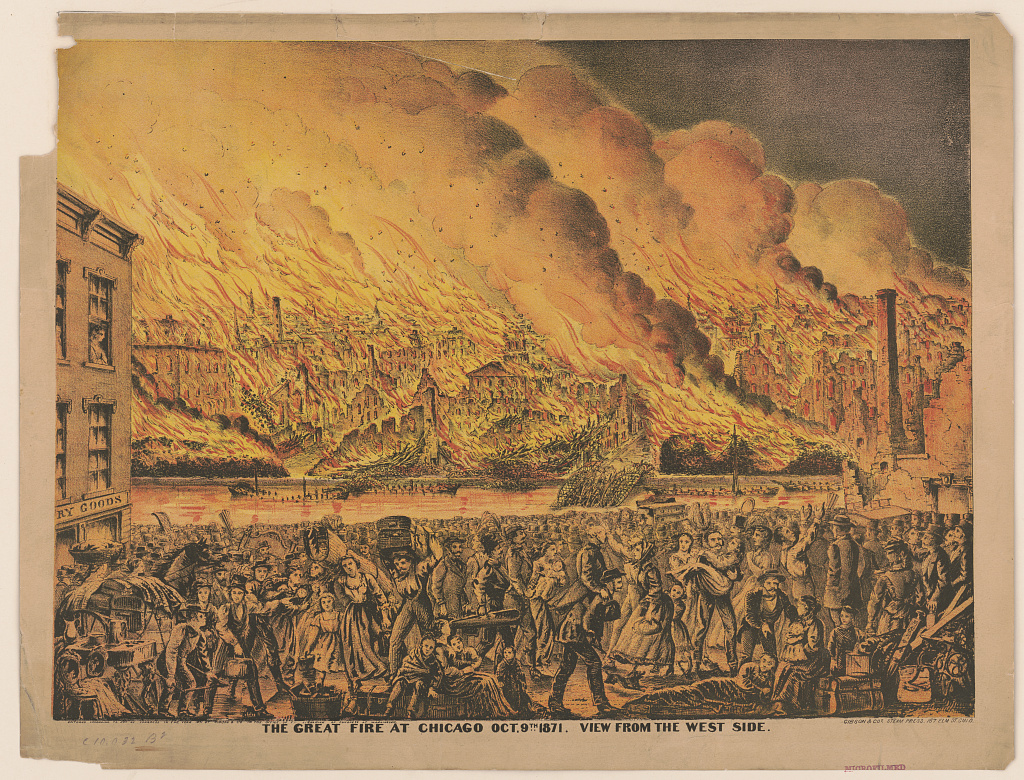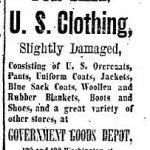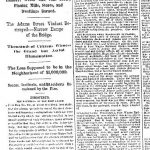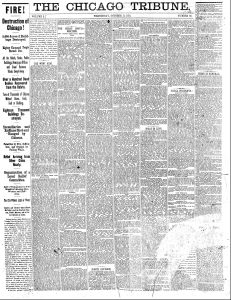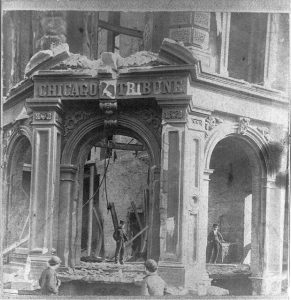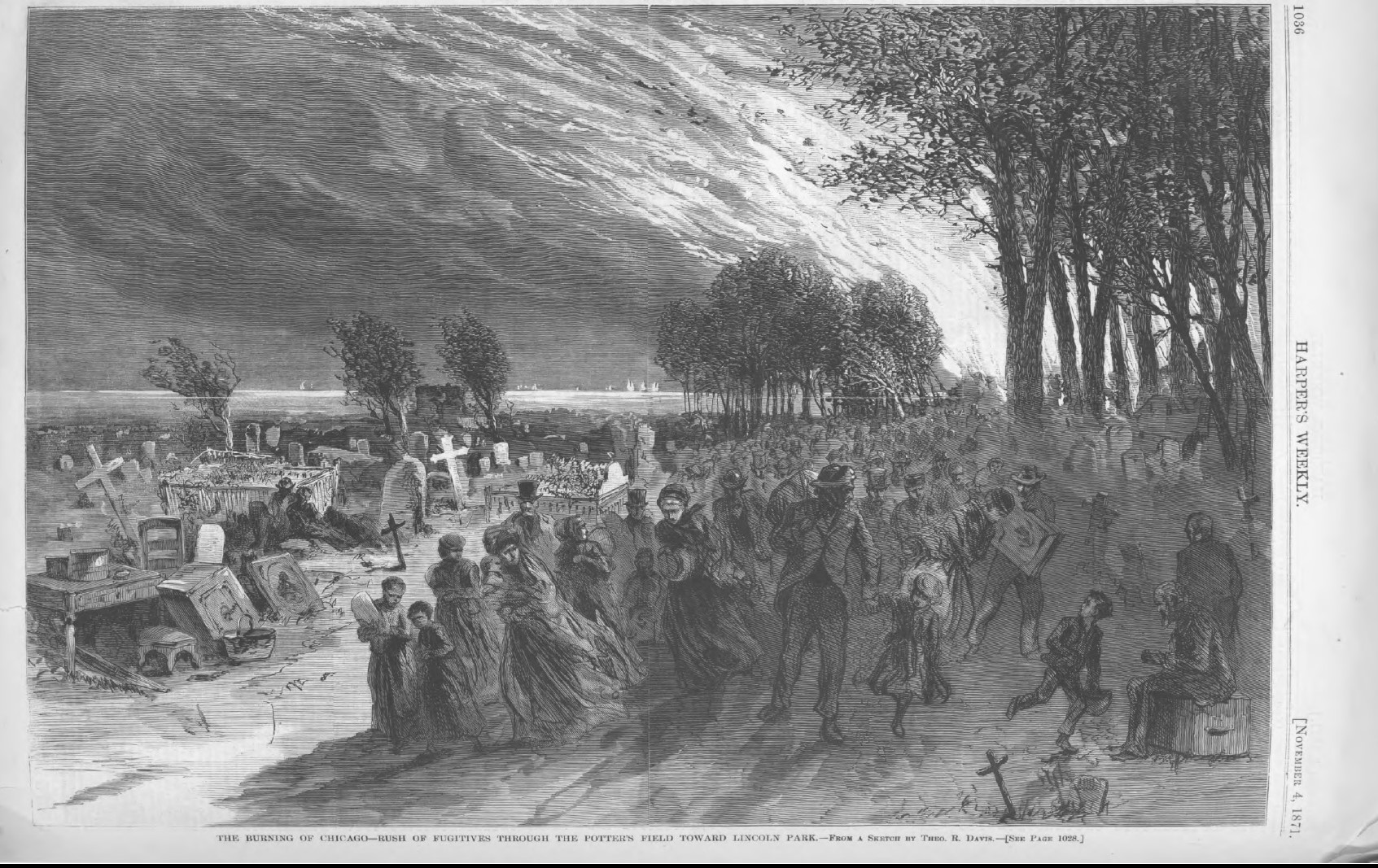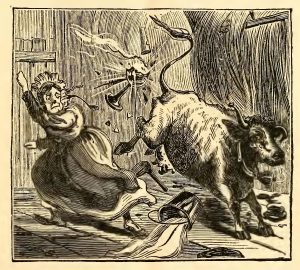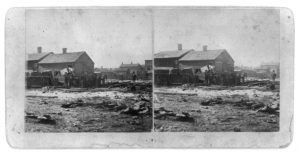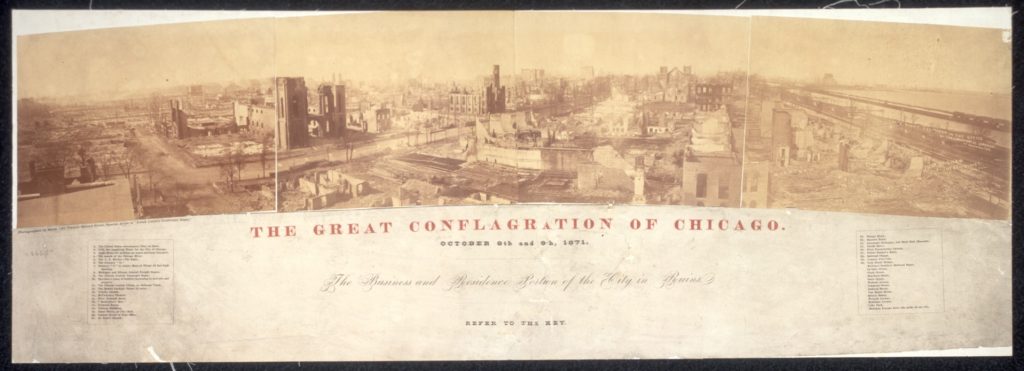I never knew much about the devastating 19th century Chicago fire, except that it seemed to have something to do with a Mrs. O’Leary and her cow. As I realized the fire was getting nearer, at least in sesquicentennial time, I naturally looked it up in Wikipedia. I found out that the Great Chicago Fire burned from the evening of October 8, 1871 until October 10th. I decided to go to the Library of Congress and check out a Chicago newspaper published on October 8th. I was looking for a little calm before the fire irony, some innocent ignorance just before the imminent calamity.
Page one of the October 8, 1871 issue of The Chicago Tribune headlined “Episcopalianism” and reported on a convention in Baltimore. So far, so good. But as I scrolled to the right I noticed an ad headlined “Great Fire, Fire” – a government surplus store was selling “slightly damaged” products. A fire sale before the great fire? How could that be? I turned to page two. There was another fire-related ad. This time an insurance company mentioned a “disastrous conflagration in the west division last night.” Last night? Now I was really suspicious. Were we somehow being hoaxed? I googled Chicago fire October 7, 1871 and sure enough, according to the Chicago History Museum, the Saturday Night Fire on October 7th appeared to be the climax of week of small fires. The October 7th fire caused an estimated one million dollars damage. “The fire will not be put out until the following afternoon, leaving firemen exhausted and their equipment in need of repair.” Page three of the October 8th Tribune reported on the “fire fiend.” The newspaper didn’t publish on October 9th and 10th.
______________________________
The first report in the October 11th issue of the Tribune stated that the fire apparently started in a “cow-barn,” but didn’t single out Mrs. O’Leary and/or her cow. The paper began with an overview of the catastrophe and a vow that the city wasn’t going to fold.
From The Chicago Tribune October 11, 1871:
During Sunday night, Monday,and Tuesday, this city has been swept by a conflagration which hat no parallel in the annals of history, for the quantity of property destroyed, and the utter and almost irremediable ruin which it wrought. A fire in a barn on the West Side was the insignificant cause of a conflagration which has swept out of existence hundreds of millions of property, has reduced to poverty thousands who, the day before, were in a state of opulence, has covered the prairies, now swept by the cold southwest wind, with thousands of homeless unfortunates, which has stripped 3,600 acres of buildings, which has destroyed public improvements that it has taken years of patient labor to build up, and which has set back for years the progress of the city, diminished her population, and crushed her resources. But to a blow, no matter how terrible, Chicago will not succumb. Late as it is in the season, general as the ruin is, the spirit of her citizens has not given way, and before the smoke has cleared away, and the ruins are cold, they are beginning to plan for the future. Though so many have been deprived of home and sustenance, aid in money and provisions is flowing in from all quarters, and much of the present distress will be alleviated before another day has gone by.
It is at this moment impossible to give a full account of losses by the fire, or to state the number of fatal accidents which have occurred. So much confusion prevails, and people are so widely scattered, that we are unable for a day to give absolutely accurate information concerning them. We have, however, given a full account of the fire, from the time of its beginning, reserving for a future day a detailed statement of losses. We would be exceedingly obliged if all persons having any knowledge of accidents, or the names of persons who died during the fire, would report them at this office. We also hope that all will leave with, or at No. 15 South Canal street, a memorandum of their losses and their insurance, giving the names of the companies.
THE WEST SIDE.
At 9:30 a small cow-barn attached to a house on the corner of DeKoven and Jefferson streets, one block north of Twelfth Street, emitted a bright light, followed by a blaze, and in a moment the building was hopelessly on fire. Before any aid could be extended the fire had communicated to a number of adjoining sheds, barns and dwellings, and was rapidly carried north and east, despite the efforts of the firemen. The fire seemed to leap over the engines, and commenced far beyond them and, working to the east and west, either surrounded the apparatus or compelled it to move away. In less than ten minutes the fire embraced the area between Jefferson and Clinton for two blocks north, and rapidly pushed eastward to Canal street.
When the fire first eugulphed the two blocks, and the efforts of the undaunted engineers became palpably abortive to quench a single building, an effort was made to head it off from the north, but so great was the area that it already covered at 10:30 o’clock, and so rapidly did it march forward, that by the time the engines were at work the flames were ahead of them, and again they moved on north. …
According to the Wikipedia article, General Philip Sheridan was put in charge of maintaining law and order from October 11th through the 24th. Wikipedia also mentioned that there has been a lot of controversy about what exactly caused the fire: it is was legend that Mrs. O’Leary’s cow kicked over a lantern – in 1893 a Tribune reporter admitted he made that part up. But the legend remained.

